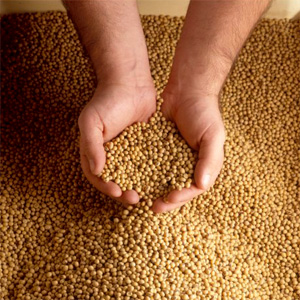 Grain futures were mixed on Thursday with wheat and corn marking minor declines, while soybeans advanced for a third day amid expectations that the USDA will trim its crop forecast in its upcoming report later today.
Grain futures were mixed on Thursday with wheat and corn marking minor declines, while soybeans advanced for a third day amid expectations that the USDA will trim its crop forecast in its upcoming report later today.
On the Chicago Board of Trade, soybeans for November delivery rose by 0.30% to $13.6250 per bushel at 8:55 GMT. Prices held in range between days high and low of $13.6488 and $13.5738 a bushel respectively. The oilseed rose 0.15% on Wednesday, a fifth daily advance in six, and trimmed its weekly decline to 0.5% following Thursdays gain.
Soybeans futures rose 13% since the end of July amid forecasts for dry and warm weather that threatened to curb yields. The USDA reported a deterioration in the crop condition for a fourth consecutive week. The government agency said on Monday that as of September 8, 16% of the crop was categorized as “Very poor” and “Poor”, compared to 15% in the preceding week and 36% a year earlier. Meanwhile, 32% of plants fell in the “Fair” category, 1% more than a week earlier and the same as the comparable period in 2012. As for the premium quality, 52% of the crop was rated good-excellent, 2% below the previous week and well above last year’s 32%.
According to a Bloomberg survey of analysts, the agency is expected to trim its August projection for soybeans by 3.7% to 3.13 billion bushels. Soybean yields forecast is likely to be trimmed to 41.2 bushels per acre from 42.6 last month.
DTN said yesterday that dryness is still the main concern for late-developing crops and this will most likely remain unchanged within the next seven days, after which increased rainfall might occur.
Profarmer Australia, a unit of NZX Ltd., said in a report yesterday: “Soybeans continue to trade weather as persistent dry conditions trim U.S. crop yields. The expectation is U.S. soybean yield estimates will be reduced.”
Meanwhile, corn futures for delivery in December fell by 0.26% to $4.7038 a bushel at 9:02 GMT. Prices ranged between days high and low of $4.7263 and $4.6875 a bushel respectively. The grain surged 0.9% on Wednesday, extending its weekly advance to little over 0.4%.
The USDA will likely cut its corn output forecast by 0.9% to 13.6 billion bushels, which however would still be record high. Corn yield projections will be reduced to 153.7 bushels per acre, down from 154 bushels estimated in August, the Bloomberg survey said.
The USDA reported that corn condition has also slightly worsened last week. As of September 8, 17% of the crop was rated very poor-poor, compared to 16% a week earlier and 52% last week. Meanwhile, 29% of plants were categorized as “Fair” from 28% in the preceding week and 26% in 2012. As for the premium quality, 54% of the crop was rated good-excellent, 2% below the previous week and 32% above the same period last year.
Elsewhere on the market, wheat declined amid prospects for favorable weather conditions for both the spring and winter wheat crops. December futures fell by 0.06% to $6.4700 per bushel at 8:56 GMT. Prices held in range between days high and low of $6.4863 and $6.4550 a bushel respectively. The grain rose by 0.2% on Wednesday but remained on negative territory following Thursdays minor retreat with a 0.1% weekly decline.
DTN reported yesterday that there is a better chance for a much-needed rainfall in the driest areas of the winter wheat bell, which would recharge soil moisture for the next crop. The USDA reported that winter-wheat planting has begun last week and 5% of the crops were planted. This compares to the five-year average of 5% and last year’s 4% during the comparable week.
DTN also said on September 11 that dry weather in the Northern Plains will improve conditions for the spring wheat harvesting. The U.S. Department of Agriculture reported that spring wheat harvesting has surpassed the five-year average pace but remained below last year’s tempo. As of September 8, 80% of the crop was reaped, marking a 16% advance from the preceding week and going 1% above the five-year average reading. During the comparable period in 2012, 97% of the crop was harvested.





